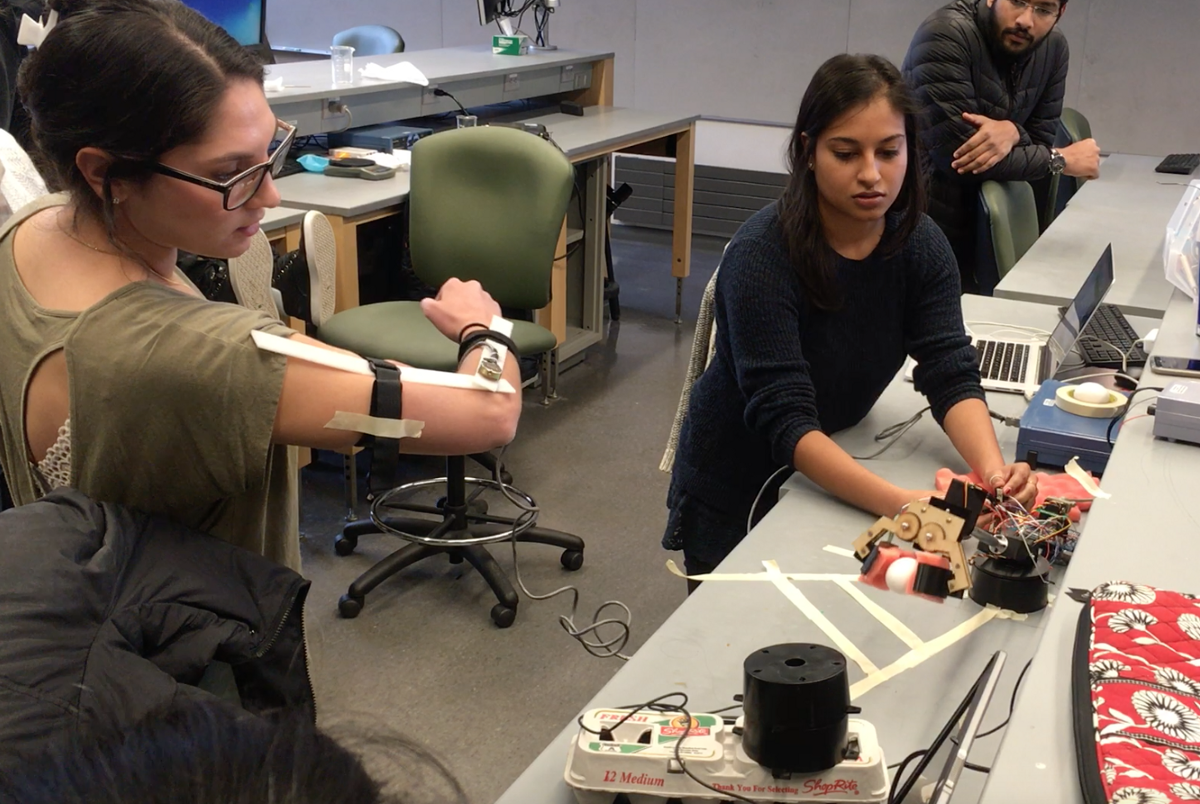Light Touch: Biomechatronics Students Strike a Balance in Designing Robotic Hands

If you’ve ever been to a boardwalk arcade, you’ve probably seen the machine into which you insert money, and a mechanical arm that you control dips down into a bunch of prizes, grabs one, and (you hope) delivers it to you.
Moving a squishy stuffed animal with a rigid metal claw should be no problem; you’d win every time if the claws weren’t rigged to loosen their grip but for a lucky few. But what if the machine contained nothing but eggs? Winning would be an even trickier proposition, and the claw’s grip would need to be strong enough to carry the prize without dropping it, but gentle enough not to break the shell along the way.
In a lab experiment last semester, Bioengineering seniors enrolled in LeAnn Dourte’s Biomechatronics class were tasked with a similar challenge: to design and manufacture a grasping tool that could move an egg from one place to another without breaking it. The goal was to demonstrate dexterity comparable to that of a human hand.
The assignment wasn’t all fun and games. Applications of biomechatronics, which combines insights from biology with mechanical and electronic engineering, have exploded in recent years. Robotic surgery is becoming increasingly common, as are mechatronic prostheses, and humanoid robots that do household tasks are eyed as future live-in assistants for the sick and elderly. Mechanical grippers that are meant to work with — or on — the human body will need to be precise in their movements and to grasp firmly but gently.

To some extent, getting a robotic arm to move up and down or left and right is an easy proposition. It requires the same basic operations as a stereo turntable. The truly difficult aspect of the project is grasping the egg without breaking it. Making the task that much more difficult is that the students had to design the gripper to close without human feedback. It needed to be automated such that, given an initial signal that starts the process, it grasped the egg entirely on its own.
One device the students used was a proportional-integral-derivative, or PID controller. While it sounds exotic, it’s actually a commonplace device, found in cruise control for cars, for example. In the case of the students’ claws, the PID controller works by monitoring feedback about predetermined settings and adjusting as necessary on the basis of external information.
“The control is responding to a variety of things depending on the student design,” Dourte said. “Things like, ‘has the maximum set force been reached on all the fingers of the claw?’ or ‘does the light sensor report darkness on all parts of the clamp, suggesting that it’s holding something?’”

Other students thought a simpler approach might be better and designed an arm that applied a pre-chosen force with which to grasp the egg, rather than an arm that would adjust according to external events.
In the end, a few eggs were cracked, but all the students succeeded. “I was impressed that each group put their personal stamp on the gripper’s design,” Dourte said, “from pneumatic silicone ‘fingers’ and four-bar linkages controlled by methods ranging from electromyography and even a Microsoft Kinect.”
The best time recorded was five seconds to pick up, move, and place the egg, covering a distance of around seven inches. While this dexterity is far from that of an actual hand, the technology has come a long way since the 1980s, and is poised to make even greater gains with Penn Engineering students on the case.
